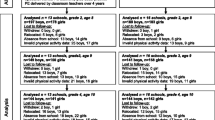Abstract
Background. Cancer is linked to obesity, and Native Hawaiian childhood obesity rates are high. We examined the feasibility of incorporating a physical activity intervention into an afterschool program for elementary school children. Methods. Anthropometric and fitness measures were taken at baseline and 12 weeks later for 68 students in 2 schools. In one, the supervisor delivered a model curriculum. In the other, a supervisor with physical education training created the curriculum. Results. We found a significant decrease in skinfold thicknesses and increase in distance covered in the 3-minute walk-run test. Conclusions. Incorporating daily physical activity into afterschool programs is feasible and effective, but teacher interest is critical, and the nonmandatory nature of this venue may limit children’s participation.
Similar content being viewed by others
References
Bray GA. The underlying basis for obesity: relationship to cancer. J Nutr. 2002(suppl 11);132:3451S-3455S.
Bray GA. Medical consequences of obesity. J Clin Endocrin Metab. 2004;89:2583–2589.
Warburton DER, Nicol CW, Bredin SSD. Health benefits of physical activity: the evidence. CMAJ. 2006;174:801–809.
Friedenreich CM, Orenstein MR. Physical activity and cancer prevention: etiologic evidence and biological mechanisms. J Nutr. 2002(suppl 11);132:3456S-3464S.
National Health and Nutrition Examination Survey, III, 1988–94. CD-ROM Series 11, No.1 and 1A. Hyattville, MD: US Department of Health and Human Services, Center for Disease Control and Prevention, National Center for Health Statistics; 1997.
Broussard BA, Johnson A, Himes JH, Story M, Fichtner R, Hauck F, et al. Prevalence of obesity in American Indians and Alaska Natives. Am J Clin Nutr. 1991;53(suppl 6):1535S-1542S.
Chai DX, Kaluhiokalani N, Little J, Hetzler R, Zhang S, Mikami J, et al. Childhood overweight problem in a selected school district in Hawai’i. Am J Human Biol. 2003;15:164–177.
Serdula MK, Ivery D, Coates RJ, Freeman DS, Williamson DF, Byers T. Do obese children become obese adults? a review of the literature. Prev Med. 1993;22:167–177.
Lifestyle Health Section. Overweight in children. Fact sheet, 2004. Available at: http://www.spc.org.nc/Lifestyle/.htm. Accessed June 27, 2005.
Michigan Department of Education. The role of Michigan schools in promoting healthy weight: a consensus paper, 2001;8–11. Available at:http://www.emc.cmich.edu/.htm. Accessed December 18, 2002.
Sothern MS. Exercise as a modality in the treatment of childhood obesity. Pediatr Clin North Am. 2001;48:995–1015.
National Alliance for Nutrition and Activity. Model Local School Wellness Policies on Physical Activity and Nutrition, 2005. Available at http://cspinet.org/nutritionpolicy.htm. Accessed June 29, 2005.
Exemplary Physical Education Curriculum (EPEC). Available at: http://www.michiganfitness.org/EPEC/default.htm. Accessed June 29, 2005.
Michigan Fitness Foundation. Physical Education as a public health initiative: Preparing students for a lifetime of physical activity. Lansing, MI: Michigan Fitness Foundation; 1998.
Lohman, TG, Roche AF, Martorell R. Anthropometric Standardization Reference Manual. Champaign, IL: Human Kinetics Publishers; 1998.
Slaughter MH, Lohman TG, Boileau RA, et al. Skinfold equations for estimation of body fatness in children and youth. Human Biol. 1988;60:709–723.
SPSS Inc. SPSS Base 10.0 for Windows User’s Guide. Chicago, IL: SPSS Inc; 1999.
Author information
Authors and Affiliations
Corresponding author
Additional information
Supported by ’Imi Hale—Native Hawaiian Cancer Network at Papa Ola Lokahi with funding from the National Cancer Institute, Center to Reduce Cancer Health Disparities (U01 CA86105), Hawaii Department of Health, and Hawaii Medical Services Association (HMSA) Foundation.
Rights and permissions
About this article
Cite this article
DeRenne, C., Maeda, J.K., Chai, D.X. et al. Afterschool physical activity program to reduce obesity-related cancer risk: A feasibility study. J Canc Educ 23, 230–234 (2008). https://doi.org/10.1080/08858190802188602
Issue Date:
DOI: https://doi.org/10.1080/08858190802188602




